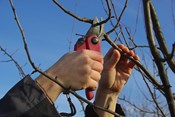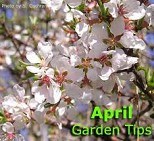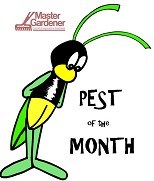Now is a good time to take a look at pruning shrubs but be careful to note when is the best to do this. Pruning at the wrong time for the plant can destroy the flowers for the year. In general one should prune spring blooming shrubs (lilacs, forsythia, weigela, viburnun for example) right after they bloom. It is the summer blooming shrubs that can be pruned now because they bloom on new growth so the more they are pruned now the better flower production there will be in the summer. There are a couple of choices on how you treat shrubs, the first is to do a maintenance pruning which involves removing any dead material and any branches that cross each other and remove the small branches of less than a pencil width. After that, take a look at the shrub and cut back any lanky growth that interferes with the shrub’s natural shape and shorten up the tips of the branches to encourage new growth. Pruning this way will give you shrubs that increase in size each year with fruit and blooms appearing on the new wood.
If you have an old shrub or one that has become too big for its space in which case one should think about doing a more drastic pruning. This involves cutting back the shrub to about four or five leaf nodes above the ground. A node is the little bulge on the stem where a leaf or branch starts. Also cut out some of the center branches to allow more sunlight and encourage new inner growth to give the shrub a fuller appearance. Some of the advantages of this technique is that leaves will usually be bolder and colors more intense. Since there will be much more new growth, the shrub will get many more fruits and blossoms and it will keep some of the more rampant shrubs in check. The Pee Gee Hydrangea is a good example of this, unchecked this shrub will grow into a huge shrub or even a small tree but by cutting it back annually it produces huge flowers and stays about five feet which is just perfect for borders. Other good candidates for drastic pruning are the butterfly bushes, russian sage, firethorn, rose of Sharon and blue mist shrubs. Spireas can be cut to a third of their height to encourage many new shoots or you can maintain an informal shrub by not cutting back so severely and by staggering your pruning cuts – cutting branches back at various heights. Elderberries are another excellent candidate for drastic pruning unless you want them to grow wild and form thickets.
Keep an eye on the weather forecast because pruning should be done about a month before new growth should emerge and after the deep freeze of winter so late February into March is an ideal time. It’s also a good time to cut back the ornamental grasses but I would hold off on rushing around and cutting all your perennials back, we may yet have some pretty cold weather and the tender perennials can easily be damaged by pruning back too early.
Just a note of caution about the tender shrubs that are woody at the base but put on green growth through the summer. These include lavenders, sages, oreganos and thymes for example. It’s difficult to differentiate between dormant live branches and dead ones so for these you are better off waiting until you see a little green before hacking away. If you do drastic pruning on these plants you may well lose them altogether. Happy Pruning!





